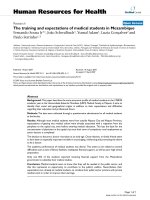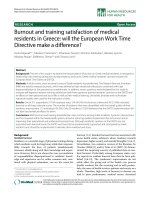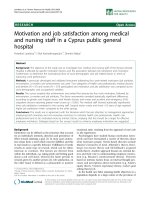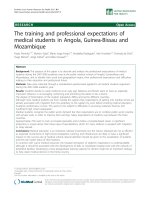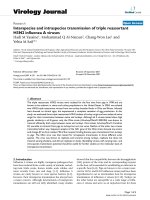báo cáo sinh học:" Profile and professional expectations of medical students in Mozambique: a longitudinal study" doc
Bạn đang xem bản rút gọn của tài liệu. Xem và tải ngay bản đầy đủ của tài liệu tại đây (219.88 KB, 4 trang )
CASE STUDY Open Access
Profile and professional expectations of medical
students in Mozambique: a longitudinal study
Paulo Ferrinho
1,2*
, Inês Fronteira
1,2
, Mohsin Sidat
3
, Fernando da Sousa Jr
1
, Gilles Dussault
1,2
Abstract
Introduction: This paper compares the socioeconomic profile of medical students registered at the Faculty of
Medicine of Universidade Eduardo Mondlane (FM -UEM), Maputo, for the years 1998/99 and 2007/08.
Case study: The objective is to describe the medical students’ social and geographical origins, expectations and
perceived difficulties regarding their education and professional future. Data were collected through questionnaires
administered to all medical students.
Discussion and evaluation: The response rate in 1998/99 was 51% (227/441) and 50% in 2007/08 (484/968).
The main results reflect a doubling of the number of students enrolled for medical studies at the FM-UEM, asso-
ciated with improved student performance (as reflected by failure rates). Nevertheless, satisfaction with the training
received remains low and, now as before, students still identify lack of access to books or learning technology and
inadequate teacher preparedness as major problems.
Conclusions: There is a high level of commitment to public sector service. However, students, as future doctors,
have very high salary expectations that will not be met by current public sector salary scales. This is reflected in an
increasing degree of orientation to double sector employment after graduation.
Introduction
In Mozambique, medical students are trained in three
faculties: two are public institutions (Faculty of Medicine
of the University Eduardo Mondlane (MF-UEM), in
Maputo, and Faculty of Health Sciences of Lúrio Uni-
versity, in Nampula) and the Catholic University in
Beira, a private institution. The Faculty of Medicine in
Beira, functioning since 2000, produced its first gradu-
ates in 2007. The Nampula faculty started in 2007. The
joint output of graduates is currently approximately 100
medical doctors per year, with a total of 817 doctors
having graduated from FM-UEM between 1975 and
2007. In addition, about 100 doctors were trained in for-
eign countries, mostly in Cuba [1].
A previous study of medical students registered for
the 1998/99 academic year in the MF-UEM, showed
that academic performance was poor, w hich students
explained by lack of library facilities, inadequate finan-
cial support, and poor high school preparation. Students
knew that they would be needed in the public sector,
and that this represented an opportunity to contribute
to the welfare of the population. Nevertheless, their
expectations were to combine public sector practice
with private medical work in order to improve their
earnings [2].
This new paper compares the pro file and expectations
of medical students from the 2007/08 academic year at
UEM with those of 1998/99.
Case description
The methodology for the 1998/99 study, as previously
described [2], is similar to the one adopted for this
most recent study. In 2007/2008, a piloted, standardized
questionnaire, with closed andopen-endedquestions,
was distributed to all registered medical students (1
st
to
7
th
year of medical education). The anonymous ques-
tionnaires, pre-tested among staff of the community
health department of the faculty, were distributed and
collected by a member of the students’ association. The
questions addressed sociodemogr aphic characteristics;
reasons for choosing medicine as a prof ession; difficul-
ties regarding the learning process in the medical
* Correspondence:
1
Associação para o Desenvolvimento e Cooperação Garcia de Orta (AGO),
Lisbon, Portugal
Full list of author information is available at the end of the article
Ferrinho et al . Human Resources for Health 2010, 8:21
/>© 2010 Ferrinho et al; licensee BioMed Central L td. This is an Open Access article dis tributed under the terms of the Creative C ommons
Attribution License (http:// creativecommons.org/licenses/by/2.0), which permits unrestricted use, distribution, and reproduction in
any medium, provided the original work is properly cited.
school; and professional and salary expectations after
leaving medical school. Some of the questions were
similar to the ones applied in the previous study and
these are the ones analysed in this paper.
The study ‘universe’ (i.e. the number of students regis-
tered for medical education) at UEM in 2007/08 was
more than double the universe of 1998/99. The response
rate in 1998/99 was 51% (227/441) and 50% in 2007/08
(484/968) and these two popula tions are compared in
Table 1. Although similar in age, there is a lower per-
centage of females in the most recent study.
Data were entered i n a Microsoft Access da tabase and
analysed with SPSS 17.0.
Discussion and evaluation
Students’ background
In both studies, a significant propo rtion of students was
born and received primary school education outside
Maputo Province and Maputo City, where the medical
school is located. On the other hand, most of the stu-
dents enrolled in the medical school completed high
school educat ion in Maputo (city or province), although
theseregionsareonlyhometoabout11.4%(6%for
Maputo Province and 5.4% for Maputo City) of the
country’s population. But these patterns are less marked
in the recent study, probably reflecting the ability of the
other faculties of medicine, outside Maputo, to absorb
candidates from other provinces, leaving UEM a greater
degree of fr eedom t o c oncentrate its intake in and
around Maputo (Table 1).
The decision to study medicine
Both groups of students took the decision to study med-
icine when they were in their late teens (Table 1).
The m ain reasons to choose medicine as a profession
were “to contribute to the welfare of the public” (60% in
1998/99 vs. 37% in 2007/08), “self-achievement” (48% in
1998/99 vs. 28% in 2007/08), “vocation” (34% in 1998/
99 vs. 23% in 2007/08) and “social recognition” (13% in
1998/99 vs. 2% in 2007/08). A reason mentioned by 2%
of th e students in 2007/08 but not in 1998/99 was that
medicine as a profession opened possibilities of a stable
job market. The dispar ity between the two set of replies
might be understood if we consider that in 1998 the
question options were closed, but open-ended in 2007/
2008. Even so, the ranking order of the reasons pre-
sented is similar for the two studies.
In 1998/99, 90% of the students reported that their
parents had in some way been associated with the health
sector: as doctors (29%), nurses (29%), other heal th sec-
tor personnel (18%), pharmacists (8%), and auxiliaries
(2%) or in some other category (5%). Furthermore, 46%
reported having uncles and/or aunts that were asso-
ciated with the health profession, with 24% having
friends working in the discipline and 30% noting other
reference people similarly involved. In 2007/08 , data
were collected in a different format (open ended ques-
tion in 1998/99 and question with closed options in
2007/08) and 45% of the students indicated that their
relatives did not have any influence on their decision to
choose medicine (only 38% of them had one or more
relatives in the health professions); 30% acknowled ged a
strong influe nce (53% had relatives in the healt h profes-
sions); and 25% some but weak influence (48% had rela-
tives in the health professions).
Academic performance
In 1998/99, 6% of the 79 first year students were repeat-
ing the year for the second o r third time. Only 32% of
the 143 students enrolled in the subsequent years had
not failed any academic year. In 2007/2008, 8% of 121
first year students were repeating the year. Although
92% of the students had not failed any academic yea r,
20% reported passing to the next academic year while
not having completed the syllabus of previous years.
Main difficulties reported
The most frequent difficulties reported (these are not
mutually exclusive) by students surveyed in 1998/99
were: “lack of reference materials/literature” (66% of stu-
dents), and “fina ncial problems” (58%). Other difficulties
were “lack of adequate technology” (22%), “teachers not
Table 1 Profile of study populations, 1998/99 (N = 227), 2008/09 (N = 484)
1998/1999 2007/2008
Age in years Mean 23 23
Range 18-36 17-43
Gender Female 61% 50%
Marital status Not married 90% 91%
Place of birth Maputo city or Province 44% 52%
Completed primary school Maputo city or Province 44% 58%
Secondary school Maputo city or Province 63% 59%
Age of decision to study medicine < 18 65% 83%
Ferrinho et al . Human Resources for Health 2010, 8:21
/>Page 2 of 4
adequately prepared” (22%), “inadequate syllabus” (8%)
and “inadequate preparedness by the high school educa-
tion system” (8%).
In 2007/2008 the main reasons for dissatisfaction with
the available support systems within the faculty were
associated with the library (55%), the computer room
(44%), with the lack of learning equipment (18%) and
with the lack of laboratory support (14%).
Satisfaction with education received
In 1998/99, 54% of the s tudents were satisfied or pa r-
tially satisfied with the burden of lecturing and learni ng
hours demanded by the medical school; 26% were
unhappy or partially unhappy with it and 20% did not
have any opinion. Regarding the quality of the training
received 52% felt it was adequate or very adequate, and
20% that it was inadequate or very inadequate and the
balance did not have any opinion.
In 2007/2008, 29% of the students were satisfied or
partially satisfied with the burden of lecturing and learn-
ing hours demanded by the medical school; 36% were
unhappy or partially unhappy with it and 35% were
neither satisfied nor unsatisfied.
Expectations regarding professional activities and income
When asked about their intentions regarding the sectors
where they would like to practice medicine after com-
pleting t heir medical education (more than one choice
possible), the proportion of students interested in dou-
ble sector employment increased from 53% in 19 98/99
to 78% in 2007/2008.
Concerning what they expect as monthly income upon
graduation, the choices are presented in Table 2, reflect-
ing a steep increase in salary expectations over the last
10 years, much above public sector salary scales.
Conclusions
Because of methodological difficulties associated with
the differing formulation of the questions in the two
studies under comparison, we do not expect our study
to be generalizable. Although not generalizable, it still
provides information and lessons that might be useful,
not only to the Maputo Faculty, but also to other
Moz ambican and African Faculties. The studies provide
longitudinal data about medical training in A frica, more
specifically in Mozambique, a theme that has received
little coverage in the literature.
In spite of the dismal student performance observed in
the past (reflected as failur e rates), a problem also
described regarding other African medical faculties
[1,3-9] this recent study is associated with improved
student performance, a not insignificant achievement in
the context where the numb er of students enrolled for
medical studies at the FM-UEM doubled.
Nevertheless, satisfaction w ith the training rece ived
remains low. Now as before–and similarly to medical
students in Angola and Guinea-Bissau–students still
identify lack of access to books or learning technology
and inadequate teach er prepar edness as major problems
[1]. Nevertheless, students remain confident that the
training received will allow them to be good, competent
doctors in Mozambique and elsewhere [10].
As for medical students in other Portuguese speaking
African c ountries [11], there is a high level of commit-
ment to public sector service. However, students, as
future doctors, have very high salary expectations that
willnotbemetbycurrentpublicsectorsalaryscales,
a finding similar to the exp ectations of medical students
in Guinea-Bissau [1]. This is reflected in an increasing
degree of or ientation to double sector employment after
graduation.
Author details
1
Associação para o Desenvolvimento e Cooperação Garcia de Orta (AGO),
Lisbon, Portugal.
2
Unidade de Sistemas de Saúde e Centro de Malária e
Outras Doenças Tropicais, Instituto de Higiene e Medicina Tropical,
Universidade Nova de Lisboa, Lisbon, Portugal.
3
Faculty of Medicine,
University Eduardo Mondlane, Maputo, Mozambique.
Table 2 Income expectations of medical students after graduation (exchange rate +26 meticais for USD)
Income (meticais) 1998/99 2007/08
N% N %
Less than 15 000 105 49.3 122 26.5
15 000 to 19 999 37 17.4 82 17.9
20 000 or more 71 33.3 251 54.6
Total 213 100.0 460 100.0
Reference salaries
1st year of
practice as
an intern
3345 meticais 8617 meticais
Top salary
for public
sector doctor
6488 meticais 16 712 meticais
Ferrinho et al . Human Resources for Health 2010, 8:21
/>Page 3 of 4
Authors’ contributions
PF wrote the protocol and questionnaire, coordinated both studies and
wrote the initial manuscript. IF carried out the statistical analysis. MS
conducted the field work in 2007/8. FS conducted the field work in 1998/9.
GD helped to conceptualize the paper and commented on all drafts. All
authors read and approved the final manuscript
Competing interests
The authors declare that they have no competing interests.
Received: 5 January 2010 Accepted: 21 September 2010
Published: 21 September 2010
References
1. Ferrinho P, Sidat M, Fresta MJ, Rodrigues A, Fronteira I, da Silva F, Mercer H,
Cabral J, Dussault G: The training and professional expectations of
medical students in Angola, Guinea-Bissau and Mozambique. Paper
presented at the Regional Health Workforce Conference: Human Resources For
Health Results (HR)2, May 10-14, 2009, Addis Ababa, Ethiopia .
2. Sousa F Jr, Schwalbach J, Adam Y, Goncalves L, Ferrinho P: The training
and expectations of medical students in Mozambique, Human
Resources for Health. 2007, 5:11 [ />content/5/1/11].
3. Adegoke OA, Noronha C: University Pre-Medical Academic Performance
as predictor of Performance in the Medical School: A case study at the
College of Medicine of the University of Lagos. Nigerian Journal of Health
and Biomedical sciences 2002, 1(1):49-53.
4. Ayeni O: A Comparative study of the performance of direct and
confessionals entrants into the University of Ibadan Medical School
1959-69. Br. J. Med. Edu 1972, 6:277-85.
5. Bamgboye EA, Ogunowo BE, Badru OB, Adewoye EO: Students’ admission
grades an their performance at Ibadan University pre-clinical MBBS
Examinations. Afr. J. Med. Sci 2001, 30:207-211.
6. Nwoha PI: Students’ attitude and predictor of performance in Anatomy.
Afr. J. Med. Med. Sci 1992, 21:41-45.
7. Olaleye SB, Salami HA: Predictor of academic performance in the pre-
clinical sciences: effects of age, sex and mode of admission at the
Maiduguri Medical School. Afr. J. Med. Med. Sci 1997, 26:189-190.
8. Oyebola M, Fasanmade AA, Oyebola DOO: Factors influencing academic
achievement of Medical Students in the basic medical sciences. Afr J.
Med. Med. Sci 1992, 21:29-34.
9. Salahdeen HM, Murtala BA: Relationship between Admission Grades and
Performances of Students in the First Professional Examination in a New
Medical School. African Journal of Biomedical Research 2005, 8:51-57.
10. Ferrinho F, Amaral M, Ferrinho P: Evolução do poder de compra dos
trabalhadores do sistema público de saúde moçambicano. Revista Médica
de Moçambique 2010, 10:59-68.
11. Ferrinho P, Fronteira I, Sidat M, Ferrinho F, Mercer H, Dussault G: Formação
médica em Moçambique: realidade e expectativas. Revista Médica de
Moçambique 2010, 10:52-58, 2010.
doi:10.1186/1478-4491-8-21
Cite this article as: Ferrinho et al.: Profile and professional expectations
of medical students in Mozambique: a longitudinal study. Human
Resources for Health 2010 8:21.
Submit your next manuscript to BioMed Central
and take full advantage of:
• Convenient online submission
• Thorough peer review
• No space constraints or color figure charges
• Immediate publication on acceptance
• Inclusion in PubMed, CAS, Scopus and Google Scholar
• Research which is freely available for redistribution
Submit your manuscript at
www.biomedcentral.com/submit
Ferrinho et al . Human Resources for Health 2010, 8:21
/>Page 4 of 4


